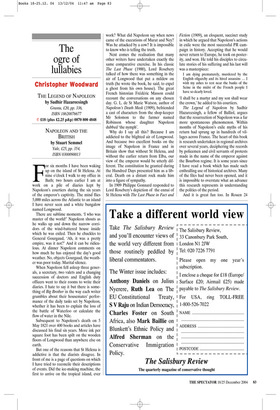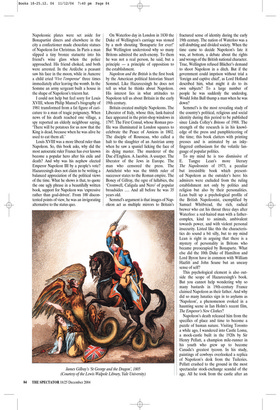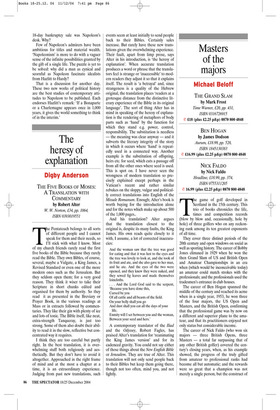The ogre of lullabies
Christopher Woodward
THE LEGEND OF NAPOLEON by Sudhir Hazareesingh Granta, £20, pp. 336, ISBN 18620076677 ✆ £18 (plus £2.25 p&p) 0870 800 4848 NAPOLEON AND THE BRITISH by Stuart Semmel Yale, £25, pp. 354, ISBN 0300090013 For six months I have been waking up on the island of St Helena. At nine o’clock I walk to my office in Bath; two hours earlier I am at work on a pile of diaries kept by Napoleon’s courtiers during the six years of the emperor’s captivity. The mind flies 5,000 miles across the Atlantic to an island I have never seen and a white bungalow named Longwood.
There are sublime moments. ‘I who was master of the world!’ Napoleon shouts as he walks up and down the narrow corridors of the wind-battered house inside which he was exiled. Then he chuckles to General Gourgaud, ‘Ah, it was a pretty empire, was it not?’ And it can be ridiculous. At dinner Napoleon comments on how much he has enjoyed the day’s good weather. No, objects Gourgaud, the weather was poor today. Marital silence.
When Napoleon fell asleep three generals, a secretary, two valets and a changing succession of doctors and English duty officers went to their rooms to write their diaries. I hate to say it but there is something of Big Brother in the way each writer grumbles about their housemates’ performance of the daily tasks set by Napoleon, whether it has been to explain the loss of the battle of Waterloo or calculate the flow of water in the Nile.
Subsequent to Napoleon’s death on 5 May 1821 over 400 books and articles have discussed his final six years. More ink per square foot has been spilt on the wooden floors of Longwood than anywhere else on earth.
But one of the reasons that St Helena is addictive is that the diarists disagree. In front of me is a page of questions on which I have tried to reconcile their descriptions of events. Did the ice-making machine, the first to arrive on the tropical island, ever work? What did Napoleon say when news came of the executions of Murat and Ney? Was he attacked by a cow? It is impossible to know who is telling the truth.
Next comes the realisation that many other writers have undertaken exactly the same comparative exercise. In his classic The Last Phase (1900), Lord Rosebery talked of how there was something in the air of Longwood that put a mildew on truth (he wrote the book, he said, to expel a ghost from his own house). The great French historian Frédéric Masson could recount the conversations on any chosen day. G. L. de St Marie Watson, author of Napoleon’s Death Mask (1909), befriended a cast of characters from the shop-keeper Mr Solomon to the farmer named Robinson whose daughter Napoleon dubbed ‘the nymph’.
Why do I say all this? Because I am addicted to the blighted air of Longwood. And because two excellent books on the image of Napoleon in France and in Britain show that without St Helena, and without the earlier return from Elba, our view of the emperor would be utterly different. The constitution he granted during the Hundred Days presented him as a liberal. Death on a distant rock made him into a figure of sympathy.
In 1909 Philippe Gonnard responded to Lord Rosebery’s depiction of the ennui of St Helena with The Last Phase in Fact and Fiction (1909), an eloquent, succinct study in which he argued that Napoleon’s actions in exile were the most successful PR campaign in history. Accepting that he would never return to Europe, he took on posterity, and won. He told his disciples to circulate stories of his suffering and his last will was a masterpiece:
I am dying prematurely, murdered by the English oligarchy and its hired assassins ... I wish my ashes to rest near the banks of the Seine in the midst of the French people I have so dearly loved.
‘I shall be a martyr and my son shall wear the crown,’ he added to his courtiers.
The Legend of Napoleon by Sudhir Hazareesingh, a fellow of Balliol, argues that the resurrection of Napoleon was a far more spontaneous phenomenon. Within months of Napoleon’s exile myths of his return had sprung up in hundreds of villages across France. The heart of this book is research undertaken in regional archives over several years, deciphering the records by policemen and civil servants of protests made in the name of the emperor against the Bourbon regime. It is some years since I have read a book which has made such enthralling use of historical archives. Many of the files had never been opened, and it is impossible to overstate what an advance this research represents in understanding the politics of the period.
And it is great fun too. In Rouen 24 Napoleonic plates were set aside for Bonapartist diners and elsewhere in the city a confectioner made chocolate statues of Napoleon for Christmas. In Paris a man slipped a tiny bronze statuette into his friend’s wine glass when the police approached. His friend choked, and both were arrested. In the Ardèche a peasant saw his face in the moon, while in Auxerre a child cried ‘Vive l’empereur’ three times immediately after leaving the womb. In the Somme an army sergeant built a house in the shape of Napoleon’s tricorn hat.
I could not help but feel sorry for Louis XVIII, whom Philip Mansel’s biography of 1981 transformed from a fat figure of caricature to a man of tragic poignancy. When news of his death reached one village, a spy reported an elderly neighbour saying, ‘There will be potatoes for us now that the King is dead, because when he was alive he used to eat them all.’ Louis XVIII was a more liberal ruler than Napoleon. So, this book asks, why did the most autocratic ruler France has ever known become a popular hero after his exile and death? And why was his nephew elected Emperor Napoleon III by a people’s vote? Hazareesingh does not claim to be writing a balanced appreciation of the political views of the time. What he shows is that, to quote the one ugly phrase in a beautifully written book, support for Napoleon was ‘expressive rather than goal-driven’. From 100 discontented points of view, he was an invigorating alternative to the status quo. On Waterloo day in London in 1830 the Duke of Wellington’s carriage was stoned by a mob shouting ‘Bonaparte for ever!’ But Wellington understood why so many Britons admired the arch-enemy. To them he was not a real person, he said, but a principle — a principle of opposition to the establishment.
Napoleon and the British is the first book by the American political historian Stuart Semmel. Like Hazareesingh he does not tell us what he thinks about Napoleon. His interest lies in what attitudes to Napoleon tell us about Britain in the early 19th century.
Britain created multiple Napoleons. The Liberator of Italy, whose thin, lank-haired face appeared in the print-shop windows in 1797. The First Consul, whose Roman profile was illuminated in London squares to celebrate the Peace of Amiens in 1802. The disciple of Rousseau, who called a halt to the slaughter of an Austrian army when he saw a spaniel licking the face of its dying master. The murderer of the Duc d’Enghien. A Jacobin. A usurper. The liberator of the Jews in Europe. The man who censored the press. The Antichrist who was the 666th ruler of successor states to the Roman empire. The Boney of Gillray, the ogre of lullabies, the ‘Cromwell, Caligula and Nero’ of popular broadsides .... And all before he was 35 years old.
Semmel’s argument is that images of Napoleon act as multiple mirrors to Britain’s fractured sense of identity during the early 19th century. The nation of Waterloo was a self-doubting and divided society. When the time came to decide Napoleon’s fate it was, at bottom, a debate about the rights and wrongs of the British national character. True, Wellington refused Blücher’s demand to shoot Napoleon in a ditch. But if the government could imprison without trial a ‘foreign and captive chief’, as Lord Holland described him, what might it do to its own subjects? To a large number of people he was suddenly the underdog. Would John Bull thump a man when he was down?
Semmel’s is the most revealing study of the country’s political, religious and social identity during this period to be published since Linda Colley’s Britons of 1988. The strength of the research is in his knowledge of the press and pamphleteering of the time; this book clatters with printing presses and is animated by an inkyfingered enthusiasm for the volatile language of popular politics.
To my mind he is too dismissive of E. Tangye Lean’s more literary The Napoleonists of 1973, a peculiar but irresistible book which presented Napoleon as the outsider’s hero: his admirers were excluded from the ruling establishment not only by politics and religion but also by their personalities. Lean built up a psychological profile of the British Napoleonist, exemplified by Samuel Whitbread, the rich, radical brewer who cut his throat three days after Waterloo: a red-haired man with a fathercomplex, kind to animals, ambivalent towards power, and with violent personal insecurity. Listed like this the characteristics do sound a bit silly, but to my mind Lean is right in arguing that there is a mystery of personality in Britons who became preoccupied by Bonaparte. What else did the 10th Duke of Hamilton and Lord Byron have in common with William Hazlitt and John Soane but an uneasy sense of self?
This psychological element is also outside the scope of Hazareesingh’s book. But you cannot help wondering why so many bastards in 19th-century France claimed Napoleon as their father. And why did so many lunatics sign in to asylums as ‘Napoleon’, a phenomenon evoked in a haunting scene in Ian Holm’s recent film, The Emperor’s New Clothes?
Napoleon’s death released him from the specifics of place and time to become a puzzle of human nature. Visiting Toronto a while ago, I wandered into Castle Loma, a mock-castle built in the 1920s by Sir Henry Pellatt, a champion mile-runner in his youth who grew up to become Canada’s greatest tycoon. In his study, paintings of cowboys overlooked a replica of Napoleon’s desk from the Tuileries. Pellatt crashed to the ground in the most spectacular stock-exchange scandal of the age. All he took from the castle after an 18-day bankruptcy sale was Napoleon’s desk. Why?
Few of Napoleon’s admirers have been ambitious for titles and material wealth. ‘Napoleonism’ is more to do with a vaguer sense of the infinite possibilities granted by the gift of a single life. The puzzle is yet to be solved: why did a man as cynical and scornful as Napoleon fascinate idealists from Hazlitt to Hardy?
That is a discussion for another day. These two new works of political history are the best studies of contemporary attitudes to Napoleon to be published. Each endorses Hazlitt’s remark: ‘If a Bonaparte or a Charlemagne appears once in 1,000 years, it gives the world something to think of in the interim.’



















































































 Previous page
Previous page